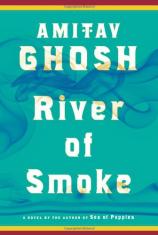Reading Group Guide
Discussion Questions
River of Smoke

1. The opening scenes recount Deeti's survival after she and Kalua escaped the Ibis. She insists that destiny, not chance, led her to the site of her hidden shrine. For her, what does destiny mean? What legacies does she pass on to the next generation?
2. Like many of the novel's characters, Ah Fatt and Robin Chinnery have bicultural ancestries. What limitations and freedoms accompany their lack of a legitimate, aristocratic bloodline? Do ancestry and prestige go hand in hand in River of Smoke?
3. Discuss Bahram's and Fitcher's motivations. Are they simply greedy?
4. Paulette is a master of disguise and can comfortably move between cultures. What does she consider to be her true identity? Why is horticulture a suitable field for her?
5. Discuss the role of religion in shaping the characters' view of the world. When Christian characters justify the opium trade, how do they reconcile it with their faith? (You may enjoy revisiting Charles King's letter to Charles Elliot near the book's final pages.)
6. Bahram and Zadig discuss the experience of having an additional, foreign wife, debating whether love is a factor. How does the relationship between Bahram and Chi-mei change over the years? Would Bahram enjoy Canton as much if he weren't a foreigner?
7. How do the trilogy's ships --- the formerly slave-trading Ibis, Fitcher's practical but eccentric-looking Redruth, and the treasure-laden Anahita (named for the Zoroastrian angel) --- reflect their passengers?
8. In chapter seven, Robin's letter describes the Pearl River as a suburb of Canton. In chapter thirteen, Zadig recalls the legend that claims the river got its name from a foreign trader who dropped a mysterious pearl. Drawing on these and other impressions, discuss the Pearl River as a character: how would you describe its powers and its personality?
9. Consider Ghosh's penchant for intertwining fates. For example, Ah Fatt had been Neel's companion in the labor prison, while Neel (qualified to work as a munshi because of the education that accompanied his noble status) is close by when Mr. Punhyqua is arrested, marking the unlikely fall of another member of the ruling class. Does Ghosh create tragicomedy or pure irony in story lines such as these?
10. Near the end of chapter six, Bahram has a chance encounter with Napoleon (a scene inspired by reported encounters between the French emperor and seafaring traders). If you had been in Bahram's position, what would you have asked Napoleon?
11. Chapter two depicts Bahram's slippery ladder escape, echoed in the last chapter. What is the effect of watching Paulette observe the aftermath of the dangling ladder? What do you imagine for Bahram after those final moments?
12. Explore the novel's closing scene, in which Deeti and Neel look at Robin's prophetic painting. Through his art and his letters, what vision of history does Robin present? Is this vision different from the novel's?
13. Although Neel is a fictional character, he was inspired by an 1820s court case in which a wealthy Bengali was convicted of forgery and sentenced to servitude. How was your reading affected by the blend of real-life and imagined figures?
14. Amitav Ghosh revels in the written word, compiling Neel's amusing, extensive Chrestomathy in Sea of Poppies and playfully exploring the French influence on the vocabulary of Deeti and other sojourners. What makes Ghosh's approach to language unique?
15. What do you predict for the third installment of the Ibis trilogy?
16. What can the modern world learn about economics and humanity from this novel? Is the history of the Opium Wars --- with international trade rivalries such as Dent and Jardine's --- repeating itself?
River of Smoke
- Publication Date: September 27, 2011
- Hardcover: 528 pages
- Publisher: Farrar, Straus and Giroux
- ISBN-10: 0374174237
- ISBN-13: 9780374174231








